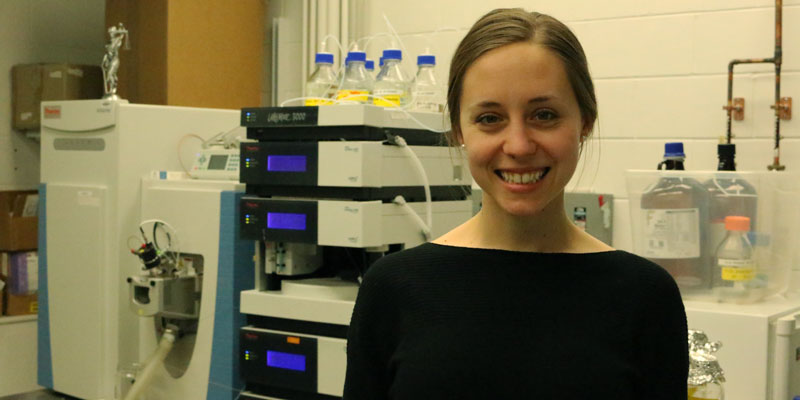Molly Tillmann, a Ph.D. student in Plant and Microbial Biology, first got her start in ecology interning at Cedar Creek for two summers as an undergraduate student. In her graduate work, she studies how plants can develop roots from aboveground organs.

Lab: Jerry Cohen
Program: Plant and Microbial Biology
Entered Program: 2014
Hometown: Vadnais Heights, MN
Describe the focus of your Ph.D. work and what drew you to this system?
I’m studying how a plant hormone, auxin, controls the root formation from aboveground plant tissues like shoots. Understanding this response has implications for trees used in agriculture, including hazelnut. I was drawn to this particular type of root growth because there are significant implications for agriculture. A number of trees — including hazelnut — can’t be grown from seed and instead are propagated by inducing rooting from existing stems. I’m using analytical techniques to study how auxin levels change when the plant starts to grow new roots. This will help us to better understand how hormones control plant development, and may provide clues as to how we can manipulate hormone treatments to more easily induce rooting for propagation.
Outside of courses and research, what else keeps you busy on campus?
Last year I worked with a diverse group of graduate and professional students from different disciplines across the U of M to provide consulting services. It’s fun to dive into a new project that’s completely different from your Ph.D. research, and often surprising to see how the skills you pick up in grad school can be applied to business challenges that may seem unrelated.
Off campus, I have a six-month-old daughter who keeps me busy when I’m not in the lab. I love seeing how much she grows and changes every day. My graduate program, department and lab group have all been incredibly supportive and helpful as I’ve transitioned to being a student parent this year, especially some of my lab mates who also have kids at home.
What has surprised you most during your studies?
I’ve learned that if all the prep work is done carefully beforehand, actually “doing” an experiment is often the easiest part. A considerable amount of effort has to go into tasks like instrument maintenance, communicating plans with the people you’re working with and making sure you have all the right reagents and equipment available, etc. Preparation and planning are key to having experiments run smoothly.
What’s your favorite place on campus to work?
I love doing experiments in the photomorphogenesis lab’s dark room. It’s completely dark except for a dim green light, which plants can’t sense very well. This allows us to see what we’re doing without triggering light responses in the plants. The quiet, dark space is a really relaxing place to work.